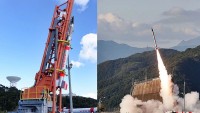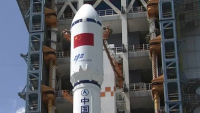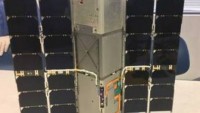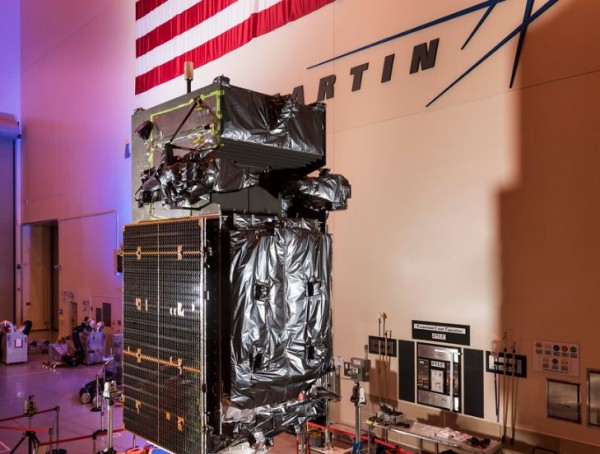Another SBIRS Missile Detection Satellite Orbited by the US
| Arthur Dominic Villasanta | | Jan 21, 2017 10:40 AM EST |
(Photo : USAF) SBIRS GEO Flight 3.
The United States' SBIRS GEO Flight 3 infrared imaging satellite designed to track infrared signatures of incoming Chinese and Russian ballistic missiles was successfully placed into geosynchronous transfer orbit after launching aboard a United Launch Alliance Atlas V rocket on Jan. 20 from Florida.
Like Us on Facebook
SBIRS (Space-Based Infrared System) is considered one of the highest priority military space programs in defense of the U.S. It's a consolidated system designed to provide global, persistent, infrared surveillance capabilities to meet 21st century demands in four national security mission areas: missile warning, missile defense, technical intelligence and battlespace awareness.
SBIRS GEO is intended to meet the United States' infrared space surveillance needs through the first two to three decades of the 21st century.
There will be four SBIRS GEO satellites. The first two began operations in 2013. There has been no announcement for the launch date of the fourth satellite.
SBIRS uses a combination of dedicated satellites in geosynchronous orbit and instrument packages hosted aboard other satellites in highly elliptical Molniya orbits.
The early detection of incoming missiles gives the U.S. military time to react to the threat of a potential nuclear attack, and launching a counterstrike. SBIRS also allows missile defense systems to be targeted to intercept the attack.
The SBIRS spacecraft are also tasked with missions described as Technical Intelligence and Battlespace Awareness, using their sensors to identify and analyze the signatures of events producing infrared radiation, and to collect data on the conditions of battlefields to aid strategic planning.
The SBIRS program falls under the operation of the U.S. Air Force's 460th Space Wing, based at Buckley Air Force Base in Colorado.
A United Launch Alliance (ULA) Atlas V rocket carrying SBIRS GEO Flight 3 satellite lifted-off from Space Launch Complex-41 on Cape Canaveral Air Force Station in Florida.
ULA is a joint venture of Boeing and Lockheed Martin with 116 successful launches under its belt after the SBIRS GEO Flight 3 mission.
TagsSBIRS GEO Flight 3 infrared imaging satellite, Space Based Infrared System, United States, U.S. Air Force
©2015 Chinatopix All rights reserved. Do not reproduce without permission
 Game Changing Japanese Mini-rocket Fails First Launch; Promise of Cheaper Flights Remains
Game Changing Japanese Mini-rocket Fails First Launch; Promise of Cheaper Flights Remains China Plans Record 30 Space Launch Missions in 2017; US had 60 in 2016
China Plans Record 30 Space Launch Missions in 2017; US had 60 in 2016 Russia again Successfully Tests an Anti-Satellite Weapon in Space
Russia again Successfully Tests an Anti-Satellite Weapon in Space NASA to launch Six Small Satellites that will take a Fresh Look at the Earth and its Weather
NASA to launch Six Small Satellites that will take a Fresh Look at the Earth and its Weather
EDITOR'S PICKS
-

Did the Trump administration just announce plans for a trade war with ‘hostile’ China and Russia?
-

US Senate passes Taiwan travel bill slammed by China
-

As Yan Sihong’s family grieves, here are other Chinese students who went missing abroad. Some have never been found
-

Beijing blasts Western critics who ‘smear China’ with the term sharp power
-

China Envoy Seeks to Defuse Tensions With U.S. as a Trade War Brews
-

Singapore's Deputy PM Provides Bitcoin Vote of Confidence Amid China's Blanket Bans
-

China warns investors over risks in overseas virtual currency trading
-

Chinese government most trustworthy: survey
-

Kashima Antlers On Course For Back-To-Back Titles
MOST POPULAR
LATEST NEWS
Zhou Yongkang: China's Former Security Chief Sentenced to Life in Prison

China's former Chief of the Ministry of Public Security, Zhou Yongkang, has been given a life sentence after he was found guilty of abusing his office, bribery and deliberately ... Full Article
TRENDING STORY

China Pork Prices Expected to Stabilize As The Supplies Recover

Elephone P9000 Smartphone is now on Sale on Amazon India

There's a Big Chance Cliffhangers Won't Still Be Resolved When Grey's Anatomy Season 13 Returns

Supreme Court Ruled on Samsung vs Apple Dispute for Patent Infringement

Microsoft Surface Pro 5 Rumors and Release Date: What is the Latest?










